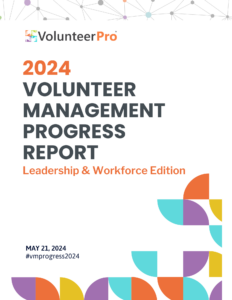How to Prevent Burnout – For Yourself and Your Volunteers
If you’re like most volunteer program administrators, you “wear many hats.” The constant need to multi-task is a critical issue that needs a solution to prevent eventual burnout.
But, given the current economic climate and budget shortfalls, it’s not likely that help is on the horizon anytime soon. To succeed in this environment, it may be time to work smarter, not harder. I have compiled a list of time saving tips that might help your volunteer program improve productivity and prevent burnout.
Time Saving Tips to Reduce a Chance of Burnout
Below are a few tips and time management strategies that can increase your productivity skills while reducing burnout. But remember that changing our well-worn behaviors takes discipline and patience. Give yourself and your team some time to adjust to any new way of doing business.
Save Your Email Until After Your First Task of the Day is Done
If you check your email first thing, then chances are you will be distracted and become less productive. Work with your team to develop “communication norms” that everyone can live with. If the expectation is that email must be responded to in 24 hours, that gives you some leeway with when you need to check it.
Include in your norms what might trigger an emergency phone call or an interruption to a meeting. This gives everyone some clear boundaries.
Chunk Your Projects & To-Dos
Research shows that people waste a tremendous amount of time just by switching from task to task. Email and social media are major culprits here, but this goes for other work as well. Try “mini-tasking” versus multi-tasking.
When possible, plan your day so that you can stay on one task until you complete it. Also, set a regular schedule for recurring activities. For example, schedule your volunteer orientation and screening on discreet days of the month and plan time-limited volunteer recruitment campaigns versus never-ending recruitment activities.
Set Limits
We actually have much more control over interruptions than we think. But we must jealously guard our “me time.” Shut your office door (or put up a “do not disturb sign” on your cube or meeting room. Set up office hours when anyone is welcome to drop by. Also, limit unnecessary meetings that eat up your time. Be sure to let volunteers and staffers know when you can be expected to be free.
Block out time on your calendar for tasks, not just meetings and travel. And, post a small whiteboard on your door that alerts everyone about your schedule and availability each day. Finally, mute the ringer on your cell phone, and turn off your social media, so that every ping doesn’t interrupt your concentration.
Work From Home When You Need To
This is easy to do during COVID, but think about extending this practice after the pandemic. When you need to think strategically or write something long or complex, such as a grant proposal or report, working from home can be a productive choice.
If your supervisor is skeptical, ask to try it for one day. Then, report back what you were able to carry out at home and compare that to the hours needed for the same task at the office. It may surprise you.
Focus, Focus, Focus
Reduce the number of new initiatives or projects you add to your plate. Work with your team to critically evaluate each project and eliminate anything that doesn’t directly contribute to your overall goals. Resist the urge for continued expansion, unless that expansion is accompanied by more people power (volunteer and/or staff based) and the necessary support infrastructure. With increased service needs, nonprofits are hard-pressed to limit services, but tough choices may be necessary. At the same time, don’t forget the tremendous human capital volunteers can bring to the table, provided some investment is made up front.
Use Technology to Help Volunteers be More Self Sufficient
There are a ton of free or low-cost web-based software options out there. Therefore, you don’t have to be a tech expert to use them. Here are a few ways to bolster communication and save you time.
Form a volunteer-led team to do some of the following:
– Set up an online resource hub (WikiSpace, Google Drive, etc.) where all-volunteer support documents (handbook, forms, training materials, etc.) and works in progress (documents that need feedback or are being developed by a team) are posted.
– Set up an online discussion group (LinkedIn group, Facebook page, Slack Channel, etc.) where volunteers can keep in touch with each other to ask questions, share ideas and info, arrange carpools, plan events, discuss scheduling, etc.
– Set up an email autoresponder for initial volunteer inquiries with links to a landing page on your website where all recruitment materials are posted, and give them step-by-step instructions on what to do.
– Set up an added auto responder, or pop up, when applications are submitted electronically, to let applicants know when they can expect an initial email or phone call.
– Post a short video featuring current volunteers welcoming newcomers on your recruitment landing page to make their initial contact more personable.
– Use video chat services (Skype, Google Meet, FaceTime, etc.) to meet with others rather than spending time on the road. Many of these will accommodate more than two people at the same time, making it easy to hold short team meetings, to
– Use an online collaborative team calendar (Google Calendar, You Can Book Me, Calend.ly, etc.) that everyone can use to schedule appointments, meetings, volunteer service dates and times, etc. without going through a central person and multiple email threads.
Get Volunteers More Involved in All Aspects of Your Program
You can decrease the chance of burnout when you surround yourself with more support. For example, you can assign volunteer outreach, recruitment, screening, and placement to a volunteer-led team. Create workflows, processes, and standardized tools. Then you can train the team on what to do at each step of the way and explain when and how to reach out for support. Set up an email specifically for interested volunteers and let the recruitment team manage it, making sure someone is assigned to check it each weekday.
Give Yourself a Break
Nonprofit workers are admired for their self-sacrifice and hard work under very challenging circumstances. Be sure to take time out for yourself. If you burnout, you’re no good to your cause. There’s nothing to be gained from burnout, but everything to gain from caring for yourself.
Burnout Prevention Tactic #1: Delegate. Delegate. Delegate … Did We Say Delegate?
Skilled and effective delegation is an art that most managers I know have not been able to master completely. In the rush to meet deadlines, respond to email, return phone calls, and handle crises, we try to communicate the best we can. Then we cross our fingers and rush to the next thing. However, is this probably not the most effective tactic in the long run. Not with our employees and certainly not with our volunteers.
Pay Attention to Communication
I’ve just brought aboard two fabulous new people to my team and have been considering how to work together in the most efficient way possible. So, I have paid attention to how I communicate the tasks they will be responsible for. We’ve been quite rushed because we are under pressing deadlines, so I’m certain I haven’t done my best in sharing what needs doing at our shop. As I’ve distributed work to my team (all working in their home offices remotely), they’ve received minor instructions, some sample documents to emulate, and some links to sources. I’ve also sent emails from time to time with more ideas and things to consider.
This is all well and good, but what results is added time spent understanding the task in later conversations, versus working on the task itself.
My team is talented, so it certainly isn’t their fault. We can also all expect to need more info from time to time. It’s just how it is when you are collaborating. Still, I’m left wondering how I can do better at delegating, so we can all save time and increase our productivity.
Once our busy period slows down a bit, I plan to circle back and work on a plan for the coming year together. Ts is one way to make delegation easier and more effective. When your team is included in the planning process, they already understand the context of their work and the tasks ahead, so explanations can be short cut.
Be Realistic with Goals
In addition, team members have a better sense of what is doable in their world. When you plan together, you can better develop realistic goals and timelines.
When you work with volunteers, saving time isn’t the only issue at stake when poor delegation occurs. Paid staff may be more resilient and able to accommodate a dysfunctional delegation style. They are paid and have come to expect it in many workplaces.
Delegate to Volunteers?
It doesn’t take too long for volunteers to become frustrated with the lack of information. They may feel “dumped on” if you assign tasks they didn’t really agree to, or if activities take more time than they have on hand to give. You may discourage volunteers by asking them to re-do a task multiple times because they weren’t given clear guidelines in the first place or the process for approval keeps changing. This is a sure-fire way to promote burnout in your volunteers.
Poor delegation hurts not only your productivity, but it can also erode your team morale and, ultimately, your volunteer retention. So, take a good, hard look at. Of course, some volunteers can “go with the flow” more than others. But if you improve your delegation skills, you can meet everyone’s need to have clear information and a chance to make a big difference at your organization.
Steps for More Effective Delegation
In the spirit of sharing, here’s how I try to improve my own delegation. Maybe these ideas will help you, too.
– Ask my staff directly how I can do better — Different people need different information, in different ways. So, the first step is knowing their preferences, so that I am sure to deliver info in a way that suits their needs.
– Gather all the necessary info needed for the project BEFORE I assign it — For example, if it’s a document, what are the graphic standards (i.e., font, layout, 508 compliance, etc.)? What are my expectations around the layout (page numbers, graphic design, etc.)? When is the interim draft due? When is the final due?
– Have a list handy of good examples to live up to, from the start — If there are other products or projects that have been successful, I need to share them (or links to them) upfront, before they get started; it will help folks visualize what the end result might look like.
– Explain the concept and context around the project more fully — People need to know how the task fits into the larger picture. Why is it important? How does the product or project interface with others? I want my team to know how each task makes a difference and adds to the whole.
– Be clear about the review process from the beginning — Who will review the drafts, and how will it be decided when the result has been achieved? This isn’t always easy to do because some projects take more tinkering with than others. But, if I can at least lay out a general process, it will help my team feel more in control, confident they are on track, and aware if they are not.
– Explain how to get help, specifically — I encourage my team to contact me at any time if they have a question, but I think people really need something more concrete. I’m a busy person, like many of you. When can they count on my undivided attention, if they have a question? Is it first thing in the day via email? Is it during a 15-minute meeting they’ve requested through my calendar software? Is it a verbal check-in at the end of the day? I’m going to consider what works best for both myself and the other person, and then stick to it.
In the end, I hope that you become more effective in delegation, we will all save time and hopefully prevent burnout in the long run. It feels like a lot to do upfront, but I’m willing to give it a try. I’m hoping that by adjusting my style, everyone will reap rewards down the line, as we become the well-oiled machine we aspire to be.
Create a Wellness Program for Volunteers
So now that you are on your way to an improvement in your delegation skills and have your workload better under control, hopefully you’ll start to feel less overwhelmed and ready to address similar feelings of burnout or fatigue in your volunteers.
Lately, I have been kicking around a new idea to support volunteer engagement efforts – Why not integrate a volunteer workplace wellness program into our volunteer recognition and retention strategies? If we are asking more and more of our volunteers, shouldn’t the level of our support be enhanced as well?
Can a business case be made for investing in volunteer wellness? Let’s take a look…
What Is a Wellness Program?
According to the Society for Human Resource Management (SHRM), 75% of employers now offer employee wellness programs to their paid staff. Traditionally, these programs have included perks such as flu shots, smoking cessation, preventive health education, fitness center memberships, weight loss programs, health fairs, and stress reduction programs to name a few.
Although many of these activities may not be right for volunteer programs (since most don’t offer health coverage to volunteers), the intent of a wellness program focused on volunteers is much the same – to support the health, safety, and well-being of those who help our organizations realize their missions.
What Are the Benefits of Wellness Programs?
Employers have recognized the value of employee wellness programs as strategies to reduce health care costs. Many studies have pointed to the significant return on investment (ROI) of these initiatives (for an in-depth US Department of Labor study click here).
Aside that and a decrease in absences related to illness, this translates to your volunteers morale, motivation, and productivity.
How a Wellness Program Can Lead to Decreased Volunteer Burnout
There may be real benefits for volunteer programs, too. When we promote the well-being of volunteers through a well-designed program, we may be able to better support their ability to make a difference and thus affect their satisfaction, enthusiasm, and depth of involvement.
Here are some possible results of such an initiative:
– A purposefully designed program may show to volunteers that they are valued and trusted members of the team, even more than traditional volunteer recognition activities.
– Offering a wellness program as a perk may make some volunteer opportunities more appealing than others.
– Because most wellness programs include group activities or education, they present a unique opportunity for volunteers to socialize, have fun, and better manage stress.
– In addition, the social nature of many wellness activities builds peer relationships that may result in greater shared accountability and higher team productivity.
– The aspirational aspects of wellness programs (as they often seek to promote positive behavioral changes) directly align with the inherent nature of volunteerism as a way to improve oneself, one’s community, and society as a whole and thus may support higher personal satisfaction with their volunteer role.
– Achievement and personal growth also feed upon themselves, promoting higher levels of self-confidence which may result in increased wiliness to undertake new challenges and even team leadership responsibilities.
Why Focus on Volunteer Health and Well-being?
Although science has yet to prove a correlation between volunteer wellness promotion and program outcomes, we have anecdotal evidence that speaks to the unique challenges today’s volunteers face. These barriers might be addressed through a wellness program explicitly designed to address these issues.
We know that some volunteers – particularly those who provide direct services – are unprepared for the reality of their roles. For example:
– Some volunteers suffer from burnout because they are not prepared for the stress of working directly with clients in crisis, and/or do not know how to maintain appropriate professional boundaries with those they serve.
– Volunteers who have little experience with the charitable sector sometimes struggle with the slow pace of change or lack of readily available resources.
– Still others experience a kind of “culture shock” as they immerse themselves in new communities and new contexts.
– Others may become demoralized with their inability to find ready solutions to some of our society’s most persistent problems.
– Some are frustrated by what they perceive as pointless reporting, paperwork, and grant requirements for the projects with which they are involved.
The increase in stress of new challenges, coupled with the disappointment of unmet expectations, creates an environment that can foster dissatisfaction in a volunteer corps (for more on volunteer expectations, see my earlier post). A volunteer wellness program may be a savvy preventive measure, as well as an antidote to current volunteer burnout and discontent.
If you were to develop a Volunteer Wellness Program, what activities would you include? Please share your ideas in the comments below!
Take Care of Yourself So That You Can Help Others
Finally, remember all the good work you do and accept your limitations so that you don’t burnout. You may not be perfect and may not always notice the ripples you make. But believe me, others do and are grateful even if they don’t or can’t tell you.
You are you, in all your fabulousness! So, be kind to yourself first and foremost.






